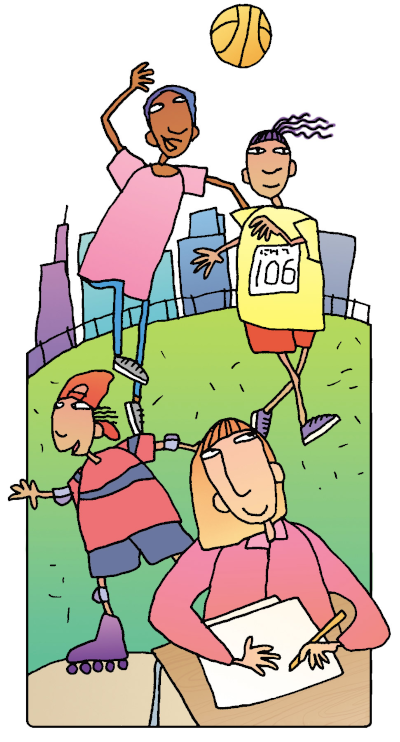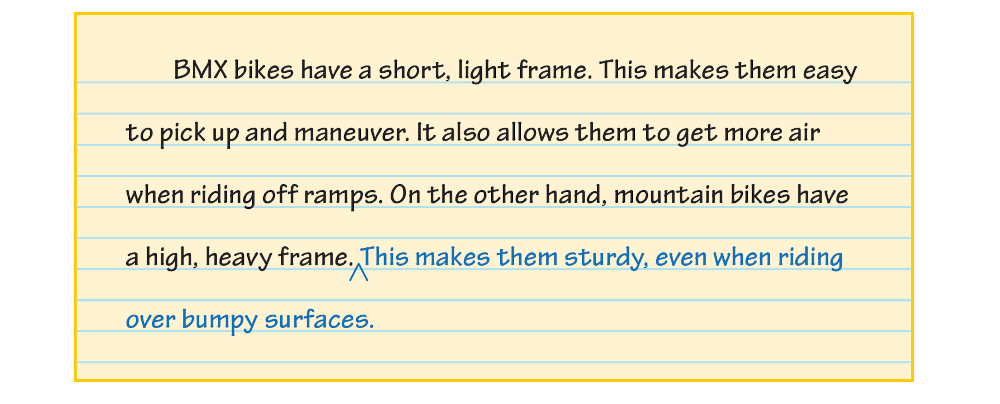Page 181
Writing Comparison-Contrast Essays

Basketball and cross country are both aerobic sports requiring strong hearts and lungs and using speed and agility. However, basketball is a team sport played on a court while cross country is an individual sport that covers miles of terrain.
When you show how two subjects are similar, you compare them. When you show how they differ, you contrast them. Writing a comparison-contrast essay can help you understand both subjects better.
In this chapter, you’ll see the similarities and differences between BMX bikes and mountain bikes. Then you’ll write an essay that compares and contrasts your own subjects.
What’s Ahead
- Sample Comparison-Contrast Essay
- Prewriting
- Writing the First Draft
- Revising
- Editing and Proofreading
WE 182
Page 182
Sample Comparison-Contrast Essay
The following essay compares and contrasts two different types of bikes. The student knows quite a bit about both kinds and does a good job of pointing out their important similarities and differences.
Notice how the essay is organized: Each paragraph covers one of the differences between the bikes. This makes the essay easy to follow.
Tricks or Travel?
Beginning
The writer leads up to his focus statement. Not all bikes are created equal. Some kids like BMX bikes best. Other kids prefer mountain bikes. It all depends on how you like to ride. BMX bikes and mountain bikes are different in three key ways.
Middle
Each middle paragraph covers an important difference. The first major difference is the frame. BMX bikes have a short, light frame. This makes them easy to pick up and maneuver. It also allows them to get more air when riding off ramps. On the other hand, mountain bikes have a high, heavy frame. This makes them sturdy, even when riding over bumpy surfaces.
The bikes have different-sized wheels, too. BMX bikes have 20-inch wheels, which are short compared to most bike wheels. In contrast, mountain bikes have 26-inch wheels with thick tires. Bigger wheels give mountain bikes better balance than BMX bikes.
WE 183
Page 183
A final important difference is in the gears. BMX bikes typically have only one gear. They rely on momentum to gain speed. But mountain bikes have many different gears. Multiple gears allow mountain bikers to go up and down all sorts of surfaces more easily.
This paragraph explains the effects of the differences. The contrasting frame, tires, and gears make for a different riding experience. Because they are short and light, BMX bikes are great for doing tricks and getting lots of air. The handlebars even spin all the way around. On the other hand, mountain bikes’ heavy frames, big wheels, and many gears make them great for riding up and down hills and off the road.
Ending
The last paragraph connects the topics to the reader. The bike type for you depends on how you like to ride. Do you like doing tricks? A BMX bike is built for you. Do you like traveling off road? A mountain bike is built for you. Try riding both types of bikes to experience the difference for yourself.
WE 184
Page 184
Writing a Comparison Essay
Prewriting Planning Your Essay
Most writing focuses on one topic, but comparison-contrast writing focuses on two topics. When you compare, you tell how the two topics are alike. When you contrast, you tell how the two topics are different. The topics you choose have to be similar to one another, but they also have to have some important differences in order to work for a comparison-contrast essay.
It’s also important that you choose two topics that truly interest you. Consider people, places, things, animals, games, events, ideas—whatever comparison you think you and your reader would enjoy.
Sample Topics
Things: A mountain bike and a BMX bike
Events: A tornado and a hurricane
Games: One video game and another video game
Times: One season of the year and another season
People: One soccer player and another player
Animals: One type of dog and another
Prewriting Choosing a Topic
One way to choose a comparison-contrast topic is to use a topic chart like the one shown below. Draw as many lines or squares as you want and label each with people, places, things, animals, events, games, and so on. Then fill in the spaces with as many possible topics as you can think of.
|
People |
Places |
Things |
Animals |
Events |
WE 185
Page 185
Prewriting Gathering and Organizing Details
Once you’ve chosen topics to write about, it’s time to gather details about them. For this type of essay, it’s a good idea to gather and organize your details at the same time. To do this, you can use one of two graphic organizers: a T-chart or a Venn diagram. Both organizers work well when you are gathering details about two subjects at the same time.
T-Chart
A T-chart is just what it sounds like—a chart that looks like a T.
- On the left side, list details about one of your subjects.
- On the right side, list details about the other subject.
- Underline any important similarities.
- Place check marks next to important differences.
|
Mountain Bike |
BMX Bike |
|
Popular High, heavy frame ✓ Hard to do tricks ✓ Rides well on smooth surfaces Rides well on bumpy surfaces ✓ Thick tires with deep grooves ✓ Has many gears ✓ |
Popular Low, light frame ✓ Easy to do tricks ✓ Rides well on smooth surfaces Rides poorly on bumpy surfaces ✓ Thin tires with smooth grooves ✓ Has no gears ✓ |
Tip As you list one detail on the left side, try to think of a similar (or different) detail to place on the right side. The similarities and differences will help you understand how to shape your essay.
WE 186
Page 186
Writing Developing the First Draft
Beginning 🟪 With all beginnings, you need to introduce your topic and inform readers what you plan to focus on. You can also include a brief story about why this topic is important to you—if that would make the introduction more interesting.
Middle 🟪 In the middle part of a comparison-contrast essay, you must decide how to arrange your details so that they are easy to understand and interesting for the reader. There are three basic ways you can arrange your details in your middle paragraphs. Choose the arrangement that works best for your topic.
Arranging Your Details
1. You can explain all of your details about one of your subjects first, and then do the same with the other subject. In other words, you might write two or three paragraphs about one subject (Mountain bike) followed by two or three paragraphs about the other subject (BMX bike). This arrangement is called subject-by-subject.
 © Thoughtful Learning 2024
© Thoughtful Learning 2024
2. Or you can write about the similarities of both subjects before discussing the differences. In this case, you might have two or three paragraphs of similarities (between the two bikes) followed by two or three paragraphs of differences. This arrangement is called similarities-and-differences.
 © Thoughtful Learning 2024
© Thoughtful Learning 2024
1. You can explain all of your details about one of your subjects first, and then do the same with the other subject. In other words, you might write two or three paragraphs about one subject (Mountain bike) followed by two or three paragraphs about the other subject (BMX bike). This arrangement is called subject-by-subject.

2. Or you can write about the similarities of both subjects before discussing the differences. In this case, you might have two or three paragraphs of similarities (between the two bikes) followed by two or three paragraphs of differences. This arrangement is called similarities-and-differences.

WE 187
Page 187
3. A third possibility is to write about one important detail for each subject before moving on to the next detail. In this arrangement, you would write one paragraph comparing and contrasting both subjects on the same detail (first, frames; then, wheels; and so on). This arrangement is called point-by-point.

Using Transitions
It’s also very important to tie your details (and your paragraphs) together as clearly and smoothly as possible. You can use the following transitions to do that.
Comparison and Contrast Transitions
Compare: Both, Alike, Similar to, Like, Also
Contrast: Each, Different, However, Unlike, On the other hand
Ending 🟪 You can end your essay by using one or more of the following strategies. The sample essay ends by connecting with readers and asking them which type of bike they might like to ride.
Restate your focus.
Offer a final comparison or contrast.
Connect with the reader.
Give a final summary or a closing thought.
Tip It’s important that you choose the best method of arranging your details. If one of the methods isn’t working for you, try another one.
WE 188
Page 188
Revising Elaborating with Details
When you review your first draft, make sure that you have included enough details to explain each topic equally. When he revised his essay, the writer added a detail about the mountain bike to make it equal to what he said about the BMX bike.

Revising Checking for Smoothness
The overall structure or flow of your essay is important. If things move along in a smooth, logical manner, the reader will be able to follow your ideas. Answer these questions.
_____ Do I introduce the topic and focus of my essay?
_____ Do I tie my details (and paragraphs) together well using transitions and signal words?
_____ Do I use different kinds of sentences to add variety and interest to my essay?
_____ Does my voice sound confident and knowledgeable?
_____ Do I end my essay with a summary or final thought?
Editing and Proofreading Polishing Your Essay
Once you have revised your essay, edit it for correctness. Also be sure to proofread your final copy. (You can use the “Editing and Proofreading Checklist” on page 66 for help.)